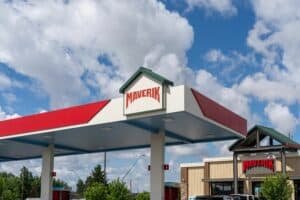
Jetcityimage2/Depositphotos.com
July 11, 2025
Is Lululemon’s US Business Facing a Rocky Road Ahead?
Athletic wear retailer Lululemon has most recently been making headlines for its much-publicized lawsuit filed against warehouse club Costco, with Lululemon alleging that Costco has been engaging in trademark infringement via the sale of ostensible “dupes” targeting the appearance of its own apparel lines.
Now, however, Lululemon appears to be making the news over an entirely different concern: the state of its U.S. business. According to a Retail Dive report outlining research presented by Jefferies, the retailer most known for its significant growth and continued physical expansion could be facing some fundamental headwinds pertaining to its stateside operations.
Significant Markdowns To Clear Inventory Could Signal Trouble for Lululemon
Per Jefferies analysis based on a number of store visits termed “lackluster” by the outlet’s Dani James, Lululemon is exhibiting signs of difficulty in clearing out existing inventory — at least at its typical pricing.
“It is becoming evident that the company is struggling with sell through and is resorting to markdowns to clear inventories,” Jefferies analysts said in a research note.
“With US sales continuing to decline, mall traffic weakening, and momentum in China fading, we see increasing risk to [management’s] topline guidance. Elevated markdown activity poses a threat to gross margins, and with costs now rising faster than sales, SG&A deleverage is set to accelerate. If current trends persist, we expect mounting pressure on earnings,” the noted continued.
Despite Costco Lawsuit, Existing Competitors Could Prove More of a Threat
And while the Lululemon-Costco suit is hogging headlines, Jefferies analysts appeared much more interested in the present danger to the apparel retailer posed by competitors like Vuori and Athleta — rival brands that often operate stores in close proximity to Lululemon’s stores.
Indicating that these brands were playing host to stores which outperformed Lululemon’s in terms of visual marketing cohesion and overall aesthetic appeal, Jefferies also pointed to data which suggests that rival retailers had begun a trend — since February of this year — of beating Lululemon on the vital metrics of digital and store traffic.
Amid pressing price increases set against a more price-conscious American consumer, a tumbling of U.S. store traffic in its most recent quarter, and stalled progress more broadly in terms of its stateside balance sheet, Lululemon remains committed to a sizable expansion of its brick-and-mortar footprint in the United States.
Can a Slate of New Product Lines Bolster the Brand?
Finally, the retailer’s pivot to focus on “newness,” as emphasized during comments made by CEO Calvin McDonald during a Q4 earnings results call, could be a risky play during a time of relative turbulence.
That’s the position taken by Jefferies, with analysts indicating “skepticism about the potential for positive impact from this new design, saying that frequent store checks reveal a very limited rollout of the product,” per James.
For his part, McDonald said in June that customers were engaging with the newer product, highlighting the incoming rollout of its No Line Align legging as a key launch, set to hit store shelves nationwide by September.
Discussion Questions
Will Lululemon’s U.S. business continue to falter in the face of stiffer competition and weak traffic? What can be done to halt, or reverse, this pattern?
Will the retailer’s international growth and new product lineup be able to fuel revitalization stateside? Why or why not?
Poll
BrainTrust
Allison McCabe
Director Retail Technology, enVista
Gene Detroyer
Professor, International Business, Guizhou University of Finance & Economics and University of Sanya, China.
Neil Saunders
Managing Director, GlobalData
Recent Discussions







Lululemon has a very sizeable US business. In women’s sporting apparel (excluding sneakers) it has the highest US market share of any brand – including Nike.
But things in retail ebb and flow. Last year, Lululemon lost market share for the first time. Comparable sales growth in the US was negative.
Why? Brands like Alo and Fabletics have picked up the pace and have taken some spending. Overlap with smaller brands like Vuori have also increased. This nibbles away at growth. As a bigger player, Lululemon is now the target.
Some consumer fatigue is also setting in. Lulu isn’t a bad retailer, but a lot of the ranges and displays currently feel a little monotonous and repetitive.
Does this spell disaster for Lululemon? No. Does it mean that the US business will slow as an engine of growth? Yes. Fortunately, Lululemon has a lot of runway on the international front.
“Some consumer fatigue is also setting in”. No kidding. Someone needs to explain to me why I need to spend $100 on leggings when I can get similar quality for a quarter of the price. Sell me on that, Lululemon, and maybe I’ll take another look.
I am making a good salary from home $1400-$2400/week , which is amazing, under a year back I was jobless in a horrible economy. I thank God every day I was blessed with these instructions and now it’s my duty to pay it forward and share it with Everyone,
Here is what I do…… https://rb.gy/y4j09o
I get paid over 220 Dollars per hour working from home with 2 kids at home. i never thought i’d be able to do it but my best friend earns over 15k a month doing this and she convinced me to try. it was all true and has totally changed my life. This is what I do, check it out by Visiting Following Website…
.
.
HERE—————⊃⫸ https://rb.gy/20rv69
Neil ‘Speedy’ Saunders
I believe that question was answered the other day: unless Lululemon can come up with a good answer to the question Neil posed, the answer to the titular question will be “yes”.
Ha! I should have just pasted in my previous comment!
I’m just hoping readers will find Retailwire a reliable source ! 🙂
Lululemon’s US business won’t collapse, but it’s entering a new phase that requires fundamentally different strategic muscles – from growth-focused to value creation-focused, and from product-centric to ecosystem-thinking. The brands that thrive will use competitive pressure as a catalyst for reinvention, rather than merely protecting existing margins. Success now depends on making the “$118 vs $8” comparison irrelevant by solving problems that cheaper alternatives fundamentally cannot address.
Competitors are on Lululemon’s heels… the price of being a successful biz is brand maturity! Nike right now is all over the place in the women’s market…brand confusion. Time is now for lulu to NOT be that way.
I’d love to see more events & action, vs lifestyle/leisure where they will continue to be haunted by the “why the high price?”.
I’d love to see Lululemon no so swayed by trend/marketing tactics…incl the play on dupes, trade them in at the store. Promos & discounts is not a 5 year business plan. Just went to their site. less than 2 seconds before a 15% off popup distraction.
They are all about summer clothes & travel clothes… so? Isn’t every store in the northern hemisphere? Leftside drop down calls out only tennis & golf by category.
I liked the lulu that was about in-store classes or events… reason to be there, a health proposition.
The recent site is apparel commerce. Lacking content or differentiation. So, yes, people will harp on the price, or sustainability, or somethings else… because the brand is getting muddled. When they start selling purses, they lose the athletic consumer who wants to be motivated to be better. Not just wear better stuff, but have it mean something.
.
The importance of overt branding definitely “ebbs and flows” as Neil so aptly put it. Right now, the need to display the Lululemon logo on one’s workout wear is taking a pause. So without something innovative in their assortment to drive some demand, the business will be taking a pause as well.
I just asked my wife a former trainer, about this. She said once upon a time, their products were high quality. She has some pants that are over a decade old and still in good shape. However, today there are many less expensive alternatives. Lulu is no longer a reasonable alternative, except for the logo.
This could be said to be a classic case of a leading brand almost creating the niche and then dominating it for years. Which of course invites competition. And look how many brands have been happy to oblige. It’s an offshoot from the Jeff Bezos maxim of “Your margin is my opportunity.” In this case it’s, “Your price point and margin are my opportunity. Thank you for creating the market and the demand!”.
A speech about “newness” is easy to make and reeeaaallly difficult to execute. There was a time I applauded Lululemon for having very little post season residue inventory. Well, that’s because they offered very little seasonal product to begin with, even at the color level. Seasons demand an ongoing flow of newness. That’s the whole point. The really difficult part is integrating seasonal product with seasonless and key item product. Lulu has already given themselves permission to step outside of pure yoga product. So they have plenty of runway in being able to offer newness. And now they are deep in the process of learning how difficult it is.
The multitude of competitors under Lulu have established themselves as very worthy competitors, not to be underestimated. So even under the best of circumstances, I think Lulu’s growth curve has flattened considerably.
Like many “trendy” brands that came before it, Lululemon has enjoyed its run of high demand and high margins and now must innovate in different ways to refuel more growth. Unless it can do that, it will have to focus on more boring things like cost of goods, logistics, etc in order to maintain margins.
Lululemon’s increased markdowns and declining traffic show how hard it is to keep premium positioning amid changing consumer behaviour. Launching new products alone won’t solve this. Lululemon needs to ensure its stores are worth visiting and that it’s stocking what people actually want to buy.
Lululemon’s challenges in the US go beyond low store traffic or discounts. The brand is starting to blend in as other players like Vuori and Athleta offer similar products with better pricing and store presentation. This makes it harder for Lululemon to stand out.
International growth may support overall numbers, but it will not fix what is missing at home. New products can help, but only if they are clearly positioned and connect with what customers want today.
To stay strong, Lululemon needs to return to what built its success. That means focusing on product value, a better shopping experience, and a brand message that still feels relevant.